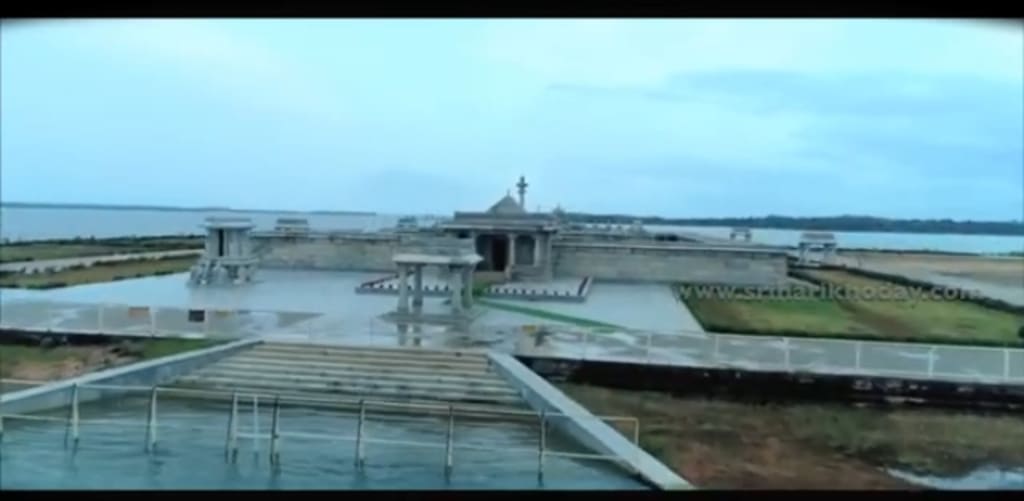Venugopala swamy temple
the godly swineherd playing a flute. positioned near the vill of Kannambadi, the tabernacle firstly stood on the banks of the River Kaveri. The tabernacle, constructed from soapstone, featured the typical Hoysala architectural rudiments similar as star- shaped platforms, intricate busts of divinities, flowery patterns, and mythological narratives. The tabernacle was a point of passage and a center of community life for centuries.

The Venugopala Swamy Temple, frequently appertained to as the" misplaced tabernacle" of Karnataka, is a striking illustration of India's rich artistic and architectural heritage. Firstly constructed in the 12th century, this tabernacle was submerged aquatic for several decades before a remarkable relocation trouble brought it back to elevation. Its story is one of literal significance, artistic preservation, and engineering phenomenon.
literal Background The Venugopala Swamy Temple was erected during the Hoysala dynasty, which is famed for its distinctive style of tabernacle armature. The Hoysalas ruled corridor of present- day Karnataka between the 10th and 14th centuries and left behind a heritage of intricately designed tabernacles. The Venugopala Swamy Temple was devoted to Lord Krishna, who's worshipped then in his form as Venugopala,
the godly swineherd playing a flute. positioned near the vill of Kannambadi, the tabernacle firstly stood on the banks of the River Kaveri. The tabernacle, constructed from soapstone, featured the typical Hoysala architectural rudiments similar as star- shaped platforms, intricate busts of divinities, flowery patterns, and mythological narratives. The tabernacle was a point of passage and a center of community life for centuries.
Immersion and relegation The fate of the Venugopala Swamy Temple changed drastically in the 1930s when the construction of the Krishna Raja Sagara( KRS) levee began under the vision of SirM. Visvesvaraya, a prominent mastermind and statesman. The levee, aimed at furnishing irrigation and drinking water to the thirsty regions of Karnataka,
needed the creation of a large force, which would submerge several townlets, including Kannambadi. Despite the brewing immersion, the tabernacle continued to serve until the water situations rose to a point where it was no longer possible. By 1934, the tabernacle, along with the entire vill, was submerged under the force waters. For decades, the tabernacle remained aquatic, visible only during ages of severe failure when water situations retreated.
rejuvenation of the Temple The story of the Venugopala Swamy Temple's rejuvenation is a testament to the fidelity of heritage conservationists and the advancements in engineering technology. In the early 2000s, as part of the Karnataka Government’s sweats to save and cover submerged literal structures, the tabernacle was linked for relocation.
The Wadiyar family of Mysore, in particular, played a vital part in this trouble, driven by their ancestral connection to the region and its heritage. The relocation design, accepted by Khodays Foundation and other stakeholders, was a mammoth task involving scrupulous planning and prosecution. The tabernacle was to be disassembled gravestone by gravestone, with each piece precisely numbered, counterplotted, and entered. This process assured that the tabernacle could be directly reconstructed at a new point. Reconstruction Process The reconstruction point chosen was roughly1.5 kilometers down from its original position, on advanced ground to help unborn immersion. The design began in 2000 and took nearly a decade to complete.
The perfection needed for this task was immense, given the intricate busts and the architectural complexity of the Hoysala style. Each piece of the tabernacle was transported to the new point and reassembled using traditional styles and accoutrements to maintain literal authenticity. Original crafters and tradesmen, professed in the traditional Hoysala ways, were employed to insure that the reconstruction stayed true to the original design.
Architectural Marvel moment, the Venugopala Swamy Temple stands as a stunning illustration of the Hoysala architectural heritage. The tabernacle's main sanctum houses the hero of Lord Krishna, depicted in his Venugopala form. The external walls of the tabernacle are adorned with intricate busts that tell stories from Hindu tradition, showcasing gods, goddesses, and elysian beings. The tabernacle complex includes several lower sanctuaries and a beautifully designed mandapa( hall) supported by intricately sculpted pillars.
The star- shaped platform, a characteristic point of Hoysala tabernacles, adds to the architectural beauty of the point. The lush surroundings of the dislocated tabernacle, set against the background of the KRS levee and the extensive force, produce a serene and graphic setting.
Artistic Significance The reanimation of the Venugopala Swamy Temple isn't just an architectural achievement but also a artistic belle epoque . It serves as a focal point for religious and artistic conditioning, drawing addicts and excursionists likewise. The tabernacle's restoration has revitalized original traditions and brought attention to the significance of conserving India's rich heritage.
The tabernacle's story is a important memorial of the adaptability and durability of artistic traditions in the face of change and adversity. It highlights the significance of heritage conservation and the part of community and government in conserving literal monuments for unborn generations.
Conclusion The Venugopala Swamy Temple's trip from a submerged relic to a restored phenomenon is a tale of devotion, perseverance, and the triumph of mortal imagination. It stands moment not only as a place of deification but also as a symbol of artistic pride and literal durability. The tabernacle's rejuvenation underscores the significance of conserving heritage spots and serves as an inspiring illustration of what can be achieved through collaborative trouble and respect for the history.
About the Creator
Enjoyed the story? Support the Creator.
Subscribe for free to receive all their stories in your feed. You could also pledge your support or give them a one-off tip, letting them know you appreciate their work.





Comments
There are no comments for this story
Be the first to respond and start the conversation.